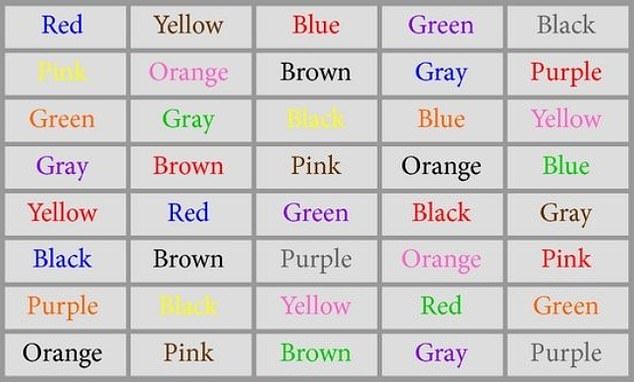The key to staying mentally alert and physically fit in old age could be a brain exercise used to expose Cold War-era spies.
In the mid- to late 20th century, American officials were wary of Russian spies lurking in the government and stealing state secrets.
To expose them, the suspected spies were given a brain exercise that involved combinations of colors and words and exposed whether Russian was their native language.
Now, researchers believe that a similar series of challenges called Brain Endurance Training (BET) can be used in older people to prevent dementia and cognitive decline.
Scientists from the United Kingdom and Spain found that older people who participated in BET exercises had better cognitive and physical results.
Of the 24 older women tested, the BET group showed more significant gains on tasks such as walking, standing on chairs, and arm bending and exhibited improved cognitive performance on attention tasks.
In the Stroop test, participants must name the ink color of a word while ignoring the word itself, which is challenging because reading is an automatic process. While the Cold War test would have been conducted in Russian, the above is an English version of the exercise.
BET also increased resilience to mental fatigue, helping participants perform better after demanding cognitive tasks. And the benefits continued to be evident at a follow-up one month later.
An example of BET is the Stroop test, in which people are shown a series of color words that spell a different color than what is written.
Test takers are asked to name the color of ink in which each word is written, not the word itself.
For example, the word “blue” can be written in red ink or “yellow” can be written in purple ink.
It is the test taker’s job to name the ink colors, not read the words, and to do it as quickly as possible.
It is rumored that this test was used to help Americans identify spies during the Cold War.
Spies may have difficulty with response inhibition (the ability to suppress automatic reactions) if they feel anxious or focused on hiding their true identity.
The words were written in Russian, so people who didn’t speak Russian could easily identify the colors without being distracted by the meaning of the words.
However, those who did speak Russian took longer to respond because they automatically processed the meaning of the words, revealing their command of the language and exposing them as spies.
While they did not conduct spy detection tests, researchers in the United Kingdom and Spain tested this type of cognitive processing on 24 healthy women from a local rural Spanish community aged between 65 and 78.
The women were randomly assigned to one of three groups: the first group underwent BET and physical training, another performed physical exercise only, and a third control group did not perform any training.
The researchers assessed the participants’ physical and mental health before the experiment began and checked their progress at week four, at the end of week eight, and again during a follow-up assessment four weeks later.

BET also increased resilience to mental fatigue among older women in a rural Spanish community, helping them perform better after demanding cognitive tasks, and the benefits remained evident at a follow-up one month later.
The researchers measured respondents’ fatigue by the number of correct answers to the Stroop test in 45 seconds.
They also measured reaction time, in which participants had to react as quickly as possible, measured in milliseconds, to a visual stimulus. A faster response indicated less fatigue.
Assessments were conducted before and after the cognitive tasks to assess how mental fatigue affects performance.
For 12 weeks, both the BET and exercise-only groups completed the same fitness training routine, consisting of three 45-minute sessions per week for eight weeks.
Each session included 20 minutes of resistance exercises, such as squats and bicep curls, and 25 minutes of walking.
All participants performed the Stroop test after their physical exercises. The main distinction was that the BET group also completed the Stroop test and the reaction time test before each training.
As part of the Stroop test, the women were asked to name the color of the ink while ignoring the actual word, a difficult task given that reading words in a mastered language is an automatic process.
When the color doesn’t match the word, the brain struggles to make sense of this contradictory information and has to prioritize one cognitive process over another, similar to when you try to rub your stomach and pat your head at the same time.
Seniors who performed the Stroop test before exercise saw better reaction times, performed better on physical tasks such as push-ups, and walked further distances in six minutes than seniors who did not undergo BET training.
The researchers also showed that older people who took the Stroop test before exercise became faster and more accurate as the experiment continued, even when they were fatigued. Their reaction times also improved with BET training.
At the midpoint, endpoint, and follow-up of the test, the BET group consistently outperformed the exercise-only and control groups in push-ups and walking endurance.
Participants in the BET group also reported feeling less tired than the control group, especially in the mid- and post-tests, suggesting that brain exercises make the body more resistant to fatigue.
The researchers said: “In support of the hypothesis of our third study, the findings show, for the first time, that BET is an effective countermeasure against mental fatigue and its detrimental effects on performance in older adults.”
They added that BET is recommended for older adults to improve performance and mitigate the negative impacts of mental fatigue on behavior, which could lead to better balance control and a reduced risk of falls and potentially fatal accidents.


